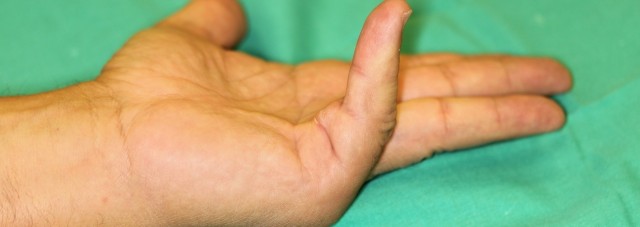Ниже вы можете прочитать перевод на английском языке человеком-переводчиком. У вас также есть доступ к испанскому оригиналу, щелкнув по флагу в правом верхнем углу. Эта ссылка дает вам доступ к версии автоматического перевода Google на русском: https://bit.ly/2V7JNfE
Dupuytren’s disease or contracture is a hereditary pathology of the palmar fascia, that is, the palm of the hand, linked to our Celtic genetic heritage. Its most characteristic manifestation is the appearance of bands of fibrous tissue that affect the flexor tendons, preventing or making it difficult for the patient to stretch the fingers
In its more advanced stages, Dupuytren’s disease ends up “sticking” the ring (most frequently affected), little, middle and index fingers on the palm, severely limiting the functionality of the hand
Dr Del Piñal offers us several key points about this non-curable pathology, which especially affects men over 60 years
Dr, which people are more susceptible to Dupuytren’s contracture?

There are various factors. The first, genetic predisposition. The incidence of this inherited disease is closely linked to the movements of the Nordic and Celtic peoples. In fact, it is much more common in northern Europe, with more aggressive manifestations than in southern countries. There are areas of the planet, such as Asia and sub-Saharan Africa where it is extremely rare.
On the other hand, there is sex and age. The ratio between male and female patients is 10 to 1. In addition, although it may appear from the age of 40, it most commonly occurs in the sixth decade. We could say that Dupuytren’s patient type is a man in his sixties.
However, the penetrance or the family inheritance incidence varies. In some cases, all the males in a family suffer from the disease, while in others it skips a generation.
What are the symptoms that point to the onset of the disease?
As a first alarm signal, there is the appearance of nodules, hardnesses on the palms, and an increasing difficulty in stretching the fingers.
As Dupuytren’s contracture progresses, the nodules thicken and form bands of diseased tissue that “bend” the fingers on the palm of the hand.

What is the most indicated treatment?
We must bear in mind that there is no cure for Dupuytren’s disease outside of surgical treatment. A surgery that, in addition, does not stop the progression of the disease but sets its ‘counter to zero’, that is, we largely eliminate the limitations it causes the patient, but these can re-emerge over time.
Thus, it is sometimes necessary to carry out several operations throughout the life of the affected person since Dupuytren’s contracture appears; especially, if it has arisen around forty years, an early age for this pathology.
On the other hand, it should be noted that amputation of the affected finger should never be accepted as a valid response to this disease. People have come to my consultation in this situation that – I insist again – should not occur.
Taking into account, Dr, that we are talking about a progressive condition, when is it advisable to start surgery?
Choosing the time of the first intervention is very important. If done too late, severe joint stiffness may have appeared; on the contrary, we shouldn’t act hastily either, since there are patients who remain in a mild stable stage for several years.
In these cases of affected but quiescent people, that is to say, ones who don’t present an intense symptomatology, a follow-up must be carried out, avoiding operating ‘for nothing’. Surgery should be performed when Dupuytren’s disease already prevents the patients from performing their daily tasks.
Dr Del Piñal, you use minimally invasive surgical techniques with this pathology, don’t you?
In effect, we resort to percutaneous surgery, which is minimally invasive, as you say, and which improves the recovery and the appearance of the operated area. In this way, we ‘cut’ the tissue bands that prevent stretching the fingers, restoring their functionality and, by extension, that of the patient’s hand.
Video: percutaneous surgery in case of Dupuytren, Dr Del Piñal
You speak just about surgery, but numerous references appear, even in mainstream press, to the treatment of Dupuytren by injecting an enzyme (…)
The enzyme treatment with collagenase, to which you refer, is highly controversial and is still in the experimental phase. One of its problems is that, sometimes, the enzyme not only “eats” diseased tissue, but also healthy tissue, causing tendon ruptures.
Its use is forbidden in Germany or France, for example, and allergic reactions have been reported.
Related content:
 es
es en
en fr
fr it
it ru
ru zh-hans
zh-hans
